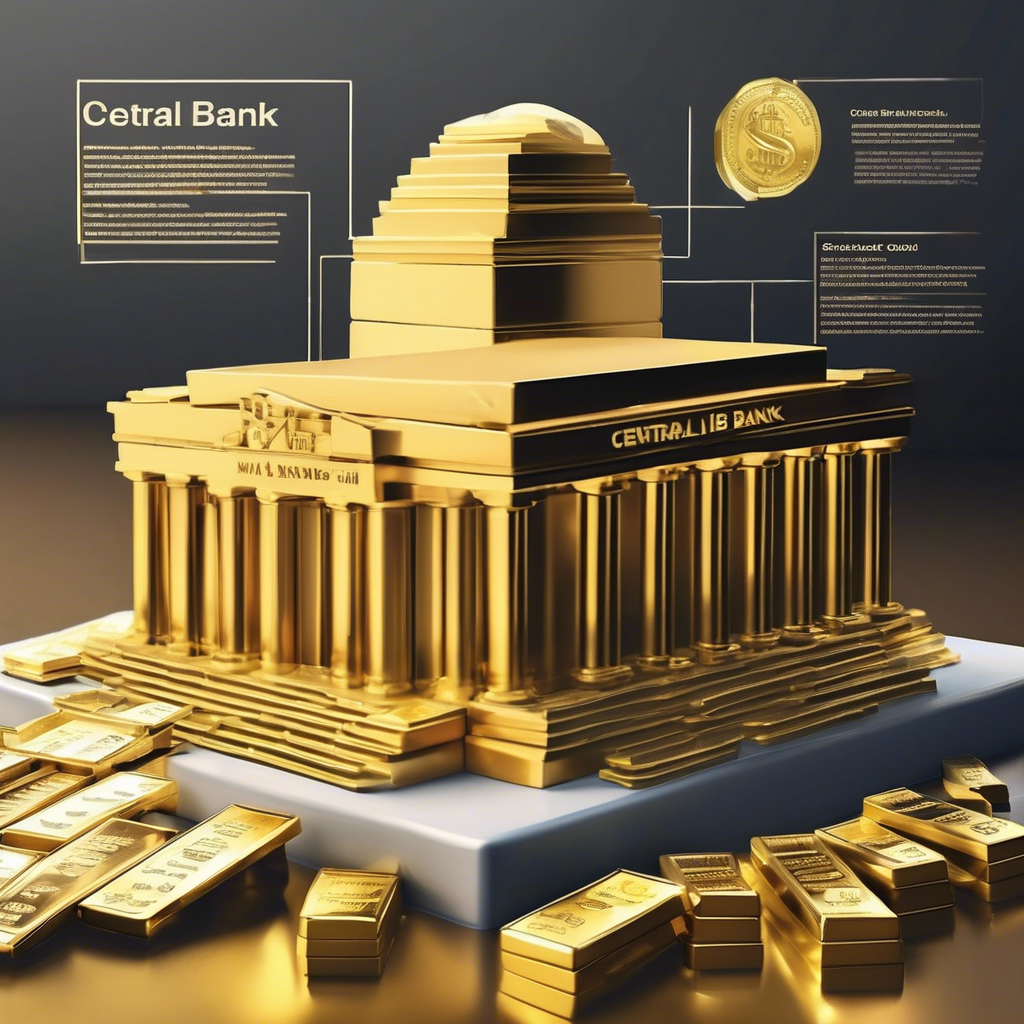Introduction to Central Bank Gold Purchases
In recent years, the role of central banks in the gold market has gained increasing attention from investors and analysts alike. Understanding central bank gold purchases is crucial for grasping the dynamics of global gold demand and its implications for the investment landscape. Central banks around the world hold substantial gold reserves, and their buying patterns can significantly influence gold prices and market sentiment.
The Significance of Gold in Central Bank Reserves
Gold has long been viewed as a safe-haven asset, especially during times of economic uncertainty. Central banks often diversify their reserves by including gold, which serves as a hedge against inflation and currency fluctuations. This practice is particularly relevant in today’s volatile economic climate, where many investors are seeking stability. With central banks increasingly turning to gold, understanding their purchasing behavior can provide valuable insights for individual investors and institutions alike.
During periods of geopolitical tension or economic instability, central banks tend to increase their gold holdings, which can lead to a rise in demand and, consequently, higher gold prices. For instance, the relationship between gold and stocks becomes particularly pronounced when investors seek alternatives to traditional equities. This trend has been observed in various countries, with central banks in emerging markets often leading the charge in gold accumulation.
Recent Trends in Central Bank Gold Purchases
In 2025, central banks have continued to ramp up their gold purchases, driven by a mix of economic strategies and responses to global market conditions. According to recent reports, nations such as China and Russia have significantly increased their gold reserves, reflecting a broader trend among central banks to bolster their financial security. This behavior can be linked to concerns over the stability of fiat currencies and the desire to maintain a diversified asset base.
The 2025 gold price forecast indicates that as central banks continue to buy gold, prices may see upward pressure, making it a critical factor for investors to monitor. Understanding the motivations behind these purchases can help investors make informed decisions about their own portfolios, as they navigate the complexities of the gold market.
Implications for Individual Investors
For individual investors, the actions of central banks can serve as a barometer for market trends and potential investment opportunities. When central banks increase their gold purchases, it may signal a favorable time to consider investing in gold-related assets, such as physical gold, ETFs, or mining stocks. By aligning their strategies with central bank behaviors, investors can position themselves to capitalize on potential market movements.
Moreover, the insights gained from analyzing gold price trends in response to central bank activities can provide a competitive edge in making timely investment decisions. As central banks play a pivotal role in shaping the gold market, understanding their purchasing patterns is essential for anyone looking to navigate the complexities of gold investing.
In summary, central bank gold purchases are not just a backdrop for the gold market; they are a significant driving force that shapes price movements and investment strategies. By keeping a keen eye on these trends, investors can enhance their understanding of the market and make informed decisions aligned with broader economic forces.
Central Banks and Their Gold Accumulation Strategies
Understanding the accumulation strategies of central banks is vital for investors looking to navigate the volatile gold market. Central banks employ various methods to enhance their gold reserves, often influenced by geopolitical and economic factors. These strategies include direct purchases from the market, acquisitions from mining companies, and gold leasing agreements, which allow them to maintain liquidity while increasing their holdings.
Recent trends show that countries like China and Russia have adopted aggressive gold accumulation strategies, often in response to fluctuating currency values and trade tensions. This proactive approach not only strengthens their financial stability but also serves as a hedge against potential global economic downturns.
The Role of Gold as a Strategic Asset
Gold’s status as a strategic asset cannot be overstated, particularly in times of crisis. Central banks often view gold as a critical component of their reserve portfolios, especially when uncertainty looms over fiat currencies. The role of gold in investment strategies becomes even more pronounced during economic instability, where traditional investments may falter.
Moreover, central bank purchases can create significant ripple effects in the market. When these institutions increase their gold holdings, it typically signals confidence in gold as a store of value. This sentiment can lead to surges in demand from individual investors, thereby driving up prices. Understanding these dynamics can help investors align their strategies with larger market movements.
Examining Historical Trends in Central Bank Purchases
A look at historical data reveals that central banks have historically increased their gold holdings during times of geopolitical tension or economic uncertainty. For example, during the 2008 financial crisis, many central banks shifted towards gold to mitigate risks associated with depreciating currencies and equity markets. As highlighted in gold market analysis, this trend has continued into 2025, with increasing purchases reflecting ongoing global uncertainties.
Understanding these historical trends allows investors to anticipate potential market shifts. When central banks are net buyers of gold, it often suggests a bullish sentiment for the market, prompting individual investors to consider increasing their own gold exposure. The relationship between central bank actions and gold prices is particularly crucial for those looking to make informed decisions regarding their investments.
Investment Opportunities Driven by Central Bank Actions
Individual investors can leverage the insights gained from central bank activities to identify lucrative investment opportunities. For instance, when central banks signal a strong commitment to gold through increased purchases, it may be an opportune time to explore various gold investment options, such as physical gold, ETFs, or even mining stocks.
Additionally, monitoring gold price trends in response to central bank purchases can provide invaluable insights. By aligning investment strategies with these larger trends, investors can enhance their potential for returns while minimizing risk.
As the landscape of gold investment continues to evolve, remaining informed about central bank gold purchases will be essential for both seasoned and new investors alike. The upcoming sections will delve deeper into the implications of these trends and how they can shape investment strategies going forward.
Understanding Central Bank Investment Strategies
Central banks implement diverse investment strategies when it comes to gold accumulation, which can offer valuable insights for individual investors. These strategies often involve assessing global economic indicators, currency stability, and geopolitical situations. By understanding these factors, investors can better anticipate market movements and align their portfolios accordingly. For example, central banks may choose to buy gold during periods of economic instability, as indicated by trends in gold market analysis.
Global Economic Indicators Impacting Gold Purchases
The influence of global economic indicators on central bank gold purchases cannot be overstated. Key indicators such as inflation rates, interest rates, and GDP growth can significantly shape a central bank’s approach to gold. When inflation is high, for instance, central banks may increase their gold holdings to hedge against currency devaluation. Investors should keep a close eye on these indicators to gauge potential shifts in central bank strategies. Furthermore, understanding how these economic factors correlate with gold price trends can enhance investment decisions.
The Interplay Between Geopolitical Events and Gold Demand
Geopolitical events often have a profound impact on gold demand, as central banks react to instability in various regions. For instance, tensions between nations or economic sanctions can prompt central banks to bolster their gold reserves as a protective measure. This behavior has been observed historically, especially during crises. Investors can utilize this knowledge to anticipate potential market fluctuations and adjust their strategies accordingly. Monitoring 2025 gold market analysis can provide further insights into how geopolitical developments might affect gold prices.
Investment Strategies for Individual Investors
Individual investors can find numerous opportunities by aligning their strategies with the actions of central banks. For instance, if a central bank announces significant gold purchases, it may be an advantageous time for individuals to consider investing in gold-related assets, such as gold ETFs or gold mutual funds. Additionally, exploring different types of gold investments can provide a diversified approach to capitalizing on market trends.
Leveraging Central Bank Insights for Portfolio Management
Understanding central bank behaviors can be an essential strategy for effective portfolio management. By integrating insights about gold purchases into their investment strategies, investors can better position themselves to capture potential gains. For example, if central banks are heavily investing in gold, it may indicate a strong bullish sentiment in the market. This is an ideal moment for investors to assess their own exposure to gold and consider increasing their holdings. Furthermore, staying informed about 2025 gold price forecasts can help investors make informed decisions regarding their investments.
Future Outlook on Central Bank Gold Purchases
As we look ahead, the future of central bank gold purchases remains a critical area of interest for investors. With ongoing global uncertainties and the evolving economic landscape, central banks are likely to continue to play a significant role in the gold market. Understanding these dynamics will be essential for investors seeking to navigate the complexities of gold investing. As new developments arise, keeping abreast of gold demand trends will be vital for making timely and informed investment decisions.
Understanding the Impact of Monetary Policies on Gold Purchases
Monetary policy plays a crucial role in shaping the dynamics of gold purchases by central banks. When central banks implement expansionary monetary policies, such as lowering interest rates or quantitative easing, they often seek gold as a hedge against potential inflation. This relationship between monetary policy and gold price trends can provide investors with valuable insights into market movements. By closely monitoring central bank announcements and their implications for monetary policy, investors can better anticipate shifts in gold demand.
The Role of Geopolitical Stability in Central Bank Gold Buying
Geopolitical stability is another significant factor influencing central bank gold purchases. Countries facing political unrest or economic sanctions often ramp up their gold reserves as a safeguard against currency devaluation and financial instability. For example, nations under sanctions may find it prudent to hold more gold to protect their assets. This behavior highlights the interconnectedness of geopolitical events and gold demand, providing individual investors with a lens through which to view potential market fluctuations.
Investment Opportunities in Gold Mining Stocks
For investors looking to capitalize on central bank gold purchases, exploring gold mining stocks can be a lucrative avenue. As central banks increase their gold holdings, mining companies may experience heightened demand for their products, leading to potential stock price appreciation. By aligning their investment strategies with the actions of central banks, investors can uncover opportunities within the gold mining sector.
Analyzing Central Bank Purchases as a Predictive Tool
Analyzing central bank purchases can serve as a predictive tool for individual investors. By tracking the buying patterns of major central banks, investors can gauge the overall sentiment towards gold in the market. Increased purchases by central banks may suggest a bullish outlook for gold, prompting individual investors to consider increasing their exposure to gold-related assets. This approach can help investors make informed decisions and stay ahead of market trends.
Key Takeaways for Investors
In summary, understanding the intricacies of central bank gold purchases is essential for both seasoned and novice investors. By acknowledging the impact of monetary policies, geopolitical stability, and analyzing purchasing patterns, investors can enhance their strategies in the gold market. Additionally, exploring gold mining stocks and maintaining awareness of 2025 price forecasts can provide valuable insights for maximizing investment returns. As the landscape of gold investing continues to evolve, staying informed and adapting strategies accordingly will be key to success in this dynamic market.
Frequently Asked Questions about Central Bank Gold Purchases
1. What are central bank gold purchases?
Central bank gold purchases refer to the activities of national banks buying gold to bolster their reserves. This practice is often employed as a strategy to safeguard against economic instability and inflation, thereby enhancing financial security.
2. Why do central banks buy gold?
Central banks buy gold to diversify their reserves, protect against currency fluctuations, and hedge against inflation. Gold is considered a safe-haven asset, especially during times of economic uncertainty.
3. How do central bank purchases affect gold prices?
When central banks increase their gold purchases, it typically leads to higher demand, resulting in upward pressure on gold prices. This relationship reflects the confidence central banks have in gold as a store of value.
4. Which countries are the largest buyers of gold among central banks?
Countries such as China, Russia, and Turkey have been recognized as some of the largest buyers of gold among central banks. Their aggressive accumulation strategies often correlate with concerns over currency stability and geopolitical tensions.
5. What is the impact of geopolitical events on central bank gold purchases?
Geopolitical events significantly influence central bank gold purchases. For instance, during periods of political unrest or economic sanctions, central banks may increase their gold reserves as a protective measure against potential financial instability.
6. How can individual investors benefit from central bank gold purchases?
Individual investors can benefit by aligning their investment strategies with central bank actions. Understanding when central banks are purchasing gold allows investors to make informed decisions about investing in gold-related assets, such as ETFs, physical gold, or mining stocks.
7. What indicators should investors monitor regarding central bank gold purchases?
Investors should monitor global economic indicators such as inflation rates, interest rates, and GDP growth, as these factors can influence central bank decisions regarding gold purchases.
8. How can central bank gold purchases serve as a predictive tool for investors?
By analyzing the buying patterns of central banks, investors can gauge market sentiment toward gold. Increased purchases may indicate bullish sentiment, prompting investors to consider increasing their exposure to gold-related investments.
9. What resources are available for further understanding central bank gold purchases?
Investors can refer to reputable financial news websites, economic reports, and studies from institutions like the World Gold Council for insights on central bank gold purchases and market analysis.
10. Is it a good time to invest in gold considering central bank behaviors?
While central bank purchases can signal a favorable time to invest in gold, individual investors should consider their financial goals and conduct thorough research before making investment decisions.
Authority Resources for Further Reading
For those interested in deepening their understanding of central bank gold purchases and their implications for the market, the following resources are highly recommended:
- World Gold Council – Offers comprehensive reports and insights on gold demand and central bank activities.
- International Monetary Fund (IMF) – Provides data and analysis on global economic indicators impacting gold purchases.
- Reuters – Features timely news articles and analysis on gold market trends and central bank actions.
- Bloomberg – Delivers in-depth financial analysis, including trends in gold and central bank purchasing behaviors.
- CNBC – Offers market updates and expert commentary on the implications of central bank gold purchases.
Conclusion
In conclusion, understanding central bank gold purchases is vital for both seasoned and novice investors navigating the complex landscape of gold investing. By analyzing these purchases, investors can gain insights into market trends, make informed decisions, and capitalize on potential investment opportunities. As central banks continue to play a pivotal role in the gold market, staying updated on their purchasing behaviors and the broader economic indicators will be essential for achieving investment success.











I find it fascinating how central banks’ gold purchases can influence not just the gold market but also signal broader economic sentiments. The article does a great job explaining how gold serves as a hedge against inflation and currency instability, which seems especially relevant now with the geopolitical tensions and economic uncertainties many nations face. In my experience following market trends, central banks increasing their gold reserves often precedes a period of heightened market volatility, reflecting caution about fiat currencies. What intrigues me is how individual investors can strategically align their portfolios based on these patterns. Do other readers find gold ETFs or physical gold more effective in reflecting central bank behaviors, or has anyone tried mining stocks as a way to benefit from these accumulation strategies? Also, I’m curious about how central banks balance liquidity needs with these gold acquisitions—does this impact the timing or method of their purchases? This perspective could be really valuable for crafting timely investment choices.
Laura, you brought up some really insightful points about central bank gold purchases and their broader economic signals. To add to that, central banks indeed face a delicate balancing act when it comes to liquidity and gold acquisitions. While gold serves as a long-term store of value and hedge against instability, these institutions must ensure they have enough liquid assets for day-to-day operations and policy implementations. As a result, some central banks might time their purchases strategically during periods of lower market volatility or use gold leasing arrangements to maintain liquidity while still increasing their reserves.
Regarding individual investors, I’ve found that physical gold offers tangible security and is preferred during times of extreme uncertainty, but gold ETFs provide more flexibility and liquidity, which can better reflect real-time market movements influenced by central bank actions. Mining stocks, while promising in uptrend markets, carry their own operational risks and don’t always align perfectly with central bank gold accumulation strategies.
What do others think about balancing these differing investment vehicles in the context of evolving central bank behaviors? Have you noticed particular patterns in timing or asset preference that seem to mirror central bank moves? Understanding this could refine how investors position themselves around these significant market players.
Building on the discussion about central banks’ gold purchasing strategies, I’ve noticed that the geopolitical factors seem to be a major driver in their aggressive accumulation, especially in nations like China and Russia. This aligns with the article’s point about gold serving as a hedge against currency devaluation during times of uncertainty. From my perspective, individual investors often overlook how these macro-level strategies can precede significant shifts in the gold market. For example, increased buying activity by central banks could signal coming volatility or a downturn in fiat currencies, nudging savvy investors to adjust their portfolios accordingly.
One aspect I find intriguing is how central banks balance their need to maintain liquidity while steadily boosting their gold reserves. It appears they sometimes utilize gold leasing or timed purchases to avoid market disruptions. This tactic might not always be visible to average investors, but understanding it can provide strategic insights.
Has anyone else observed instances where central bank activity tipped off broader market shifts before mainstream recognition? Also, with the 2025 gold price forecast suggesting upward pressure, what are your thoughts on the timing for entering gold-related assets given these signals? It seems keeping a close eye on central bank behaviors and geopolitical developments may enhance investment timing and risk management.